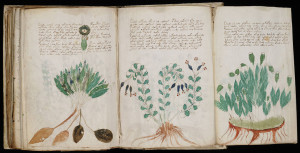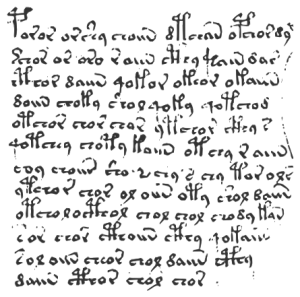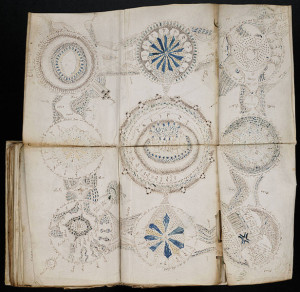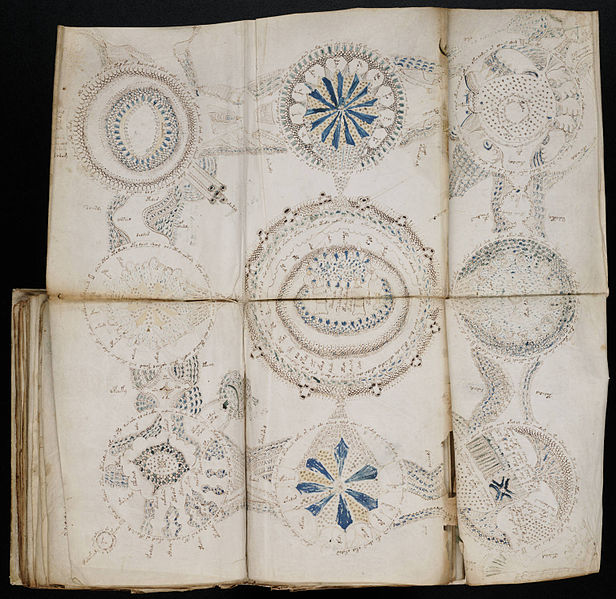 I am pleased to offer the following guest post by Nicolai Anichkin. I respect his thoughts and find them interesting.
I am pleased to offer the following guest post by Nicolai Anichkin. I respect his thoughts and find them interesting.
The post may require a bit of understanding for the Voynich Manuscript beforehand, however. I’ve previously written a summary on the VM which might help fill you in on what is considered the most mysterious Manuscript in the world here: The Voynich Manuscript. Within that post, and in comments below it, are links to further informational sites and images for the manuscript as well.
Nicolai Anichkin lives in Kaluga, Russia and is a retired Radio Engineer. At 67 years he enjoys contemplating the mysterious decoded text. Realize the below translation of language, from Russian to English, may seem awkward at times in reading. However, don’t let this distract you from the very intriguing proposals Nicolai is offering. Enjoy!
The Indecipherable Voynich Manuscript by Nicolai Anichkin
In general, the Voynich manuscript is a collection of drawings of plants, pie charts, unknown female rituals and much text. By outward appearances it can be attributed to what is an encyclopedic reference book.
Analysis of the methods of approach to deciphering the Voynich manuscript showed that all of them had one mistake. All of them were trying to relate signs written in the Voynich manuscript to letters of the alphabet of a language, the language of Europe. This approach yielded no results. Therefore, it is necessary to change the method of approach to deciphering. Namely, it is necessary to find a language, the structure of the alphabet that corresponds to the structure of the system of signs used for writing CF. Ie endosulfan was not an isolated sign, nor the whole system of signs as a whole.
Now it is necessary to find MV system in a variety of characters that are written. When I analyzed the application to the Voynich manuscript signs I could find such a system. It should be noted, later it turned out that in the whole system, there are signs which have no corresponding letter. But this is explained by the peculiarities of the language.
 The question arose to find a language format of the alphabet which would coincide with the format marks of the Voynich manuscript. Searches yielded results. They found an ancient language, format (or structure) of the alphabet which coincided with the format (or structure) of characters used in the text MV. But not everything went smoothly. According to the structure of complex characters and alphabet of the alleged identical language, the number of letters were several more. I had to go back to the text. As a result, the text was discovered by a numerical mark. I used this mark as a hint and assigned a certain number of characters on the two letters, everything fell into place.
The question arose to find a language format of the alphabet which would coincide with the format marks of the Voynich manuscript. Searches yielded results. They found an ancient language, format (or structure) of the alphabet which coincided with the format (or structure) of characters used in the text MV. But not everything went smoothly. According to the structure of complex characters and alphabet of the alleged identical language, the number of letters were several more. I had to go back to the text. As a result, the text was discovered by a numerical mark. I used this mark as a hint and assigned a certain number of characters on the two letters, everything fell into place.
Later in the translation of some short words, the fixing marks of letters were confirmed. This is the second level of encryption MB. Further, by analyzing the text with existing data revealed that in the words that begin with vowels, the vowels are omitted. This can be considered the third level of encryption.
These two circumstances in the future exclude the possibility of using computer software to translate text MB. “Manual” as the translation is difficult. For example, if a word in the text consists of 4 characters, the intended word will correspond to eight letters, four of which must be excluded. Thus, without perfect knowledge of the language of ancestors hardly do without. Myself, in translating short words, used information obtained from the Internet. They are there, as you know, limited, and only common usage. And in this case we have a specific theme.
It should be noted, it can be clearly seen that the Voynich manuscript describes at least three themes, namely: botany, medicine and astronomy. For one person, a detailed knowledge in such diverse areas is a bit much. The conclusion – this MV collected information from different sources.
If you know that the Voynich manuscript was written in the 15th century origins, the knowledge it describes were then known much earlier. It is believed that the knowledge they used was from our ancestors in the so unjustly forgotten Vedic times. At that time, were the features. For example, the calendar was different. Namely the year (summer) had three periods: winter, spring, autumn; in each period was three months, each month, there were 40 (41) days of the week was 9 days (and it is preserved to this day in the remembrance of the dead: 9 and 40 days), 16 hours a day. Other features of the Vedic chronology and astronomical knowledge discussed below at the opening of the individual Voynich manuscript.
We must now determine the cause of encryption essential knowledge.
 Knowing accurately the time of writing the Voynich manuscript and language used to identify areas where it was written to easily determine which historical events took place in the area. It was found that in this territory at this time there was the conquest of one people by another. And not just the conquest, but the change of religion. It is known that the change of religion, faith – is more painful than the occupation. From this we can conclude that all these intimate knowledges of our ancestors have been collected in one place and are encrypted to preserve them from enemies.
Knowing accurately the time of writing the Voynich manuscript and language used to identify areas where it was written to easily determine which historical events took place in the area. It was found that in this territory at this time there was the conquest of one people by another. And not just the conquest, but the change of religion. It is known that the change of religion, faith – is more painful than the occupation. From this we can conclude that all these intimate knowledges of our ancestors have been collected in one place and are encrypted to preserve them from enemies.
On further “journey” of the document until the second half of the 16th century is unknown. Perhaps its content to those from whom he was hiding behind him and organized hunting. Logically thereto must be a key that could, or even may be stored in a different place, namely at the point of writing. Moreover, one cannot exclude that the keeper of the keys looking for the document, but its common name from the truth, and that makes it impossible to find him. But this assumption is that, in principle, cannot be excluded and should be checked.
Using the above the so-called botanical section is translated following short words (short text of the Voynich manuscript): Sweet drink nectar. Food, food. Pleasure, enjoyment. Grain bread. Six. Drink absorb. Ripening, maturity. Rich. Hemp, hemp, hemp clothing. Food, food. Maybe. Clean (intestine). Drink. Desire. Knowledge. Sweet drink nectar and others. There is no doubt that the correlation coefficient is the meaning of these words and images of plants is very high.
So, on p. 20 translated words: hemp, hemp clothing; food, food. Indeed, even in our recent past on my native land cultivated hemp from which the thread, then the fabric and clothing. Furthermore therefrom gave an oil which was used for cooking. Moreover, among the many species of cannabis easily find alike. Next we have the word “six”. Bearing in mind the Vedic week of 9 days, we have 6 weeks, or 54 days, or almost two months in the modern calendar. And it is during the full maturation of most plants. These first transfer the data give reason to believe the selected translation algorithm CF right.
By the way, among a sufficiently large number of plants we see potatoes, which was imported from America. This is to ensure that the part of experts believe that the CF is home to Mexico. But during his writing potatoes used to the full.
Now go to pie charts. The first one on page 57/1 (114) on the numbering on the Internet). The diagram consists of four parts. In each of the silhouette of a man, for which it is impossible to determine its gender (this remark further play a role). Therefore the information in this figure applies to all, regardless of gender. In this diagram, a lot of short words are able to translate. This of commonly used words, namely: sour milk. Milk product. Cooked food. Mealtime. Sometimes. Some. Contribute. Yes, eat. There is no doubt that in this case we are talking about the organization of proper, healthy diet.
Now why four parts. Referring to the Vedas, we find that the power of our ancestors were four-time. Next. In each part we find the same group of words that are translated as follows: anyone. Speak. Praise. Located. Referring to the Vedas we find that before each meal one of those present at the table should say praise to our gods and ancestors. Thus it can be concluded that in this figure it is not just about good nutrition, but also the ritual meal.
Next, consider the chart posted on p. 70-74 (127-134). All charts are similar to each other. A distinctive feature of the chart is that it is the center of their zodiac sign. But we find only 10 characters of the 12 existing ones. The reason is as follows. According keeper CF knows that part of the CF sheets found. In this section, we see that for the leaf number 73 of the next sheet with the number 75, ie, offline sheet 1, on which are placed two further diagrams.
Consider the diagram on p. 70 (127). In the middle of the diagram is most likely a sign of Pisces. Around in concentric circles placed a total of 30 female figures with notes. In the following two diagrams author depicted the same signs of the zodiac, but each figure fifteen female figures. Nevertheless, this sign of the zodiac corresponding to the thirty pieces of women. The situation is similar in the remaining figures. As a result, we have the following:
– The figures on the charts especially women;
– All the signs of the zodiac correspond to a specific number of female figures, namely the thirty;
– In most cases mark next to the female figures located at the same location, different.
It is reasonable to assume that between the signs of the zodiac, the silhouettes of women and the number of “30” to be probable link. We take into account the fact that according to the Vedas in the week, it was nine days. Multiplying the thirty-nine days we get two hundred and seventy days. But this time at least familiar to all women. This is the full period of the pregnant woman. Now it is clear why the diagrams show only the figures of women and thirty.
Based on the above by itself leads to the conclusion on these diagrams show particular periods of pregnancy in women with conception during the different signs of the zodiac. The proof of this in one of the charts, I was able to two words: It is possible. Born.
Next, at p. 67 (121) 2 taken diagram. Consider the first of them. Figure is a circle divided into 12 sectors. In each sector, is inscribed the word and placed a certain number of stars, and their number is not constant. With high probability we can assume that this diagram shows a year on the lunar calendar. At the time of the lunar calendar year consisted of 12 months. The word in the sector is the name of the month, and the number of stars indicates the number of stars in the zodiac sign corresponding to that month. On the outer circumference of the chart, apparently describes the essence of these months.
Continued on the following page, which also housed two charts. The first of them is likely to show the main phases of the moon, namely: new moon, first quarter, full moon, last quarter. Circumferentially apparently describes these phases.
On the next page, the first figure also applies to the Moon. It shows the two main phases of the moon: the new moon and full moon, and also placed 29 Stars. The number of stars corresponds to the number of days in the lunar month (28.5). According to the Vedas every day of the lunar month had its name.
Further, there are a few charts. Again, according to the Vedas Vedic era was the so-called Circles of time. The main of them is a circle and the circle of life years. With a large share of probability, it can be assumed that part of the diagrams MB and there are circles of time. Thus, p. 86/1 (158) has 9 circular patterns. According to the Vedas sun is moving in its orbit passes through 9 elements. Perhaps these elements and are shown in this figure.
There are plausible explanations for some of the other sections. But they have yet to be confirmed.
That’s what managed to get by using existing techniques. Of course, with the help of a professional translation You can get more significant results. Nevertheless, the results are highly likely to give grounds for believing that.
1 .Ukazannaya method of decoding the Voynich manuscript is his key and can be used for further translation.
2. The Voynich manuscript is a kind of encyclopedia of ancient knowledge, or the book of life of our ancestors.
Perhaps this knowledge would be relevant today.
~Nikolai Anichkin
Applications. Copies of pages from MV translated words, 15 pages.


A lot of work went into the manuscript’s creation. It must hide something. Nice ideas presented.
I’ve taken a long hard look at the VM as well, and offer my thoughts. What is odd about the VM is that it uses the same letter repetitively within the same word, and that word is then repeated within a single sentence; sometimes up to six times. While many Asian languages such as Malay and Bahaset will indicate plurals by repeating a noun twice, what is occurring in the VM is far different and very strange. There is no known example of any other document written in this manner.
A typical VM sentence rendered in “Voynese” will start with an elaborate T or F-appearing symbol, and then fall into a repetitive cursive, which looks similar to a chain of the letters “c” “w” “g” and interspersed with what appears to be numbers such a 4 and 8. A “typical” VM sentence looks similar to “8ccwc 8ccwc 8ccwc 4wc wgc wgc wc8 ccwc wgw wgw”…and these same “words” are found below plants, below women, below stars, below literally everything, to the point where they simply cannot said to describe what they appear to be connected to.
Additionally, there are no mistakes. The text is crisp and clean, and without hesitation, while virtually all the plants and rituals appear to be fabrications of imagination- and all of it is written on a very expensive vellum substrate- (in other words, the products used to produce the book would have cost a fortune). Only one drawing has been positively identified; that of a castle which matches exactly one built in north central Italy.
All of this has led many researchers to suggest the entire thing is authentic yes, but produced 600 years ago as a fake alchemy book, with the intention by its author to sell it to some unsuspecting rube. I’m not sure I agree with that summation, as the sheer amount of work which went into the illustrations, illustrations which also appear to be linked thematically, would not seem worth the time and expense to have produced it. As a professional artist, the amount of work that went into producing the VM would have taken years- that is too much time for someone looking to make easy money.
My take-away of the VM is thus mixed. Very few people were literate in the early 1400s (which is the agreed upon time period; between 1405 and 1430). Typically, only the clergy and the nobles could read and write, and the alchemists and scientists of the period were typically of noble birth to begin with- so the list of culprits would have to be small. Clearly, there are also no Christian themes in the book, which is unusual given the time period. There appears to be a connection to the seasons, to childbirth, to agriculture and botany…but if so, the attempt to render the latter is extremely amateurish. No one could take the drawings of the VM and apply it to the plants in one’s garden.
So, a big part of me wants to suggest that the VM is not a serious work, but rather something produced by a very offbeat son or daughter (and I lean heavily towards daughter because of the themes in the book), of a wealthy noble. She was probably considered a little, or extremely, strange for her day, possibly autistic or socially inept/solitary, and/or purposefully kept away from her peers out of embarrassment by her parents- and these same parent(s) indulged her unusualness and lack of a normal future with easy access to pen and ink, paint and vellum with which to express herself. This person then spent her life producing imaginary doodles of what she was allowed to observe (which was scant), accompanied by a fake language she developed, which actually says nothing at all.